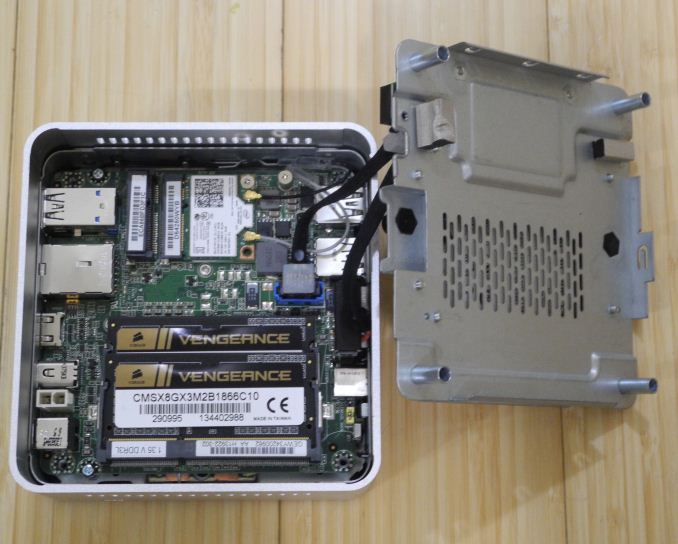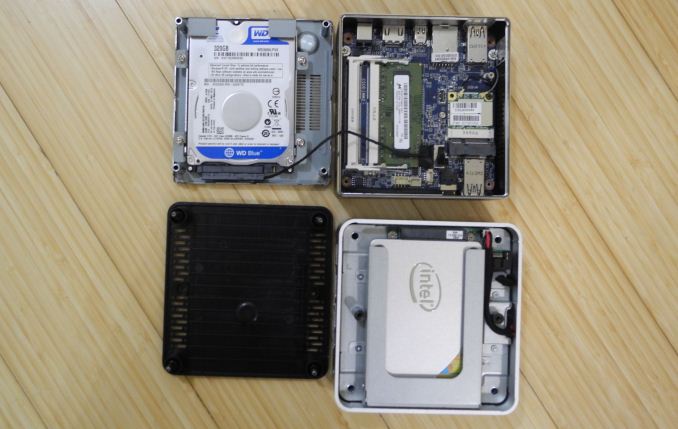Intel D54250WYKH Haswell NUC Kit with 2.5" Drive Slot Mini-Review
by Ganesh T S on May 18, 2014 10:15 AM EST
Introduction
The Intel NUC category has been an interesting product line to analyze, as it provides us with insights into where the traditional casual / home use desktop market might end up. This year, we have already reviewed two different NUC systems, the Intel D54250WYK and the Logic Supply Core ML320. The Intel D54250WYKH is fundamentally the same as the D54250WYK, except for the presence of a 2.5" drive slot. Since we have already looked at the performance of the Haswell i5 NUC platform in detail, this mini review will give us a chance to comment on the chassis redesign as well as an opportunity to see what different DRAM and storage can do to performance.
Inside the D54250WYKH:
In terms of external looks, the only difference between the D54250WYK and D54250WYKH are in the height of the system. Our D43250WYKH NUC kit came with an Intel SSD 530 240 GB 2.5" drive pre-installed. It could be accessed after removing the four screws holding the underside cover to the chassis.
While the Wi-Fi card (Intel AC-7260) that we saw in the D54250WYK review was present here too, we were free to choose the RAM this time around. Corsair came forward with a 8 GB Vengeance high performance DDR3L SODIMM kit capable of running at up to 1866 MHz with a CAS latency of 10 cycles.
Accommodating the 2.5" Drive:
Since the performance of the i5-4250U in the NUC board is quite well known (after two reviews), one of the important aspects that we cover in this review is the chassis modification for accommodating the 2.5" drive. For comparison purposes, we use a pre-production sample of the BRIX H-series PC (this is the standard BRIX board with the chassis slightly redesigned to accept 2.5" drives up to 9mm in height. The internal layout of the support for the 2.5" drive in both the versions is visible in the picture below.
While Gigabyte has opted to mount the drive bay flush against the chassis lid, Intel has a metal contraption on top of the motherboard in which the drive bay is integrated. The gallery below gives a closer look at both the designs. The first three pictures show the BRIX H design where the SATA data and power pins are brought out from the board to interface with a thin horizontal connector cable. This type of cable used to be popular during the netbook era (and even now, in notebooks such as the Razer Blade Pro). At the other end of the connector cable, we have a breakout into the standard SATA data and power connector for interfacing with the disk drive (as shown in the top segment of the photograph above).
The last three photographs in the gallery above show the Intel approach. Since the NUC board has separate SATA data ports and power connectors on the motherboard, Intel is unable to provide a clean solution to the problem of interfacing with the 2.5" drive. In the first of the Intel NUC photos in the gallery above, we have the power connector on the top metal layer visible. We can follow this to the SATA power connector on the main board by unscrewing the metal layer. This also provides us with a look at the SATA data cable which connects to a similar slot on the metal layer. All these results in the height of the chassis being more for the D54250WYKH compared to the BRIX H model. It is also not a surprise that disassembling the BRIX H to install a new drive / mSATA SSD / RAM is much easier than doing the same on the NUC chassis with the 2.5" drive slot.
In the rest of this review, we will have a few sections presenting various benchmark results (including wireless and storage system evaluation numbers). A section on power consumption and thermal performance precedes the concluding remarks. However, prior to all that, we have a table presenting the details of various systems that are compared against the D54250WYKH in this review.
| Comparative PC Configurations | ||
| Aspect | Intel D54250WYKH | |
| CPU | Intel Core i5-4250U | Intel Core i7-3720QM |
| GPU | Intel HD Graphics 5000 | Intel HD Graphisc 4000 |
| RAM |
Corsair Vengeance CMSX8GX3M2B1866C10 10-10-10-32 @ 1866 MHz 2x4 GB |
Super Talent W1333SB4GH 9-9-9-24 @ 1333 MHz 2x 4GB |
| Storage |
Intel SSD 530 Series (240 GB, 2.5in SATA 6Gb/s, 20nm, MLC) |
Intel® SSD 330 Series (60 GB, SATA 6Gb/s, 25nm, MLC) |
| Wi-Fi |
Intel Dual Band Wireless-AC 7260 (2x2 802.11ac - 867 Mbps) |
N/A |
| Price (in USD, when built) | $671 | $1300 |
























36 Comments
View All Comments
ganeshts - Monday, May 19, 2014 - link
The Wi-Fi drivers used for testing were installed by Wireless_17.0.0_De164.exe downloaded from Intel's AC7260 downloads site on 29th April.I believe the driver version is: 17.0.0.34
I have also seen some strange behaviour with the AC7260 card -- it performs worse than Realtek's 1x1 in some cases, and much behind Broadcom's 2x2 solutions in the PC space. Not sure how much of that is related to the presence of Broadcom in the Nightjawk platform (will present exact numbers in the upcoming reviews)
I have not used WPS on the Nighthawk, but it is entirely possible -- I too had some issues of slow network speeds with certain clients when using the Nighthawk for the first couple of months, but one of the recent firmware updates made it much better
tipoo - Sunday, May 18, 2014 - link
I'm curious about that 250 dollar AMD Brix APU based system in this same form factor. Seems like a lot of compute for that much money.ayejay_nz - Sunday, May 18, 2014 - link
Are you referring to the GB-BXA8-5545? I'm really looking forward to seeing a review on that unit! Could be a really well priced 'HTPC' streaming box.tipoo - Sunday, May 18, 2014 - link
I think it might be, it's the one detailed here. I'd love an Anandtech review of it toohttp://arstechnica.com/gadgets/2014/04/review-giga...
It helps that I get free windows licences, but it seems like an awefully competent computer for 250, especially with an SSD, quad core, and 8GB RAM.
nirolf - Monday, May 19, 2014 - link
I'm hoping for a Kabini BRIX. With some form digital audio output it would be just great.skiboysteve - Monday, May 19, 2014 - link
I just ordered the top of the line mSATA Intel NUCs for a work demo system. Was perfect size and had mounting bracket. I didn't need WiFi either and it had all the ports I needed. Great deal.Hilarious though, when you open the box it has a speaker that goes off with the Intel inside sound. "dun.... Dun dun dun dun"
wintermute000 - Monday, May 19, 2014 - link
Where are the dual nic models? Would be over them like a rash (quiet always on low power esxi, vcenter+pfsense+ad in a box)fackamato - Monday, May 19, 2014 - link
Use VLANadityarjun - Monday, May 19, 2014 - link
Instead of writing "Habey BIS-6922" and "Logic Super Sayian ML320" , just write the relevant configuration or something.Habey whatever doesn't mean anything to me and I just wanted a quick look at benchmarks to see how it would compare to say an i3 or i5 base model cpu.
I wanted to see whether it was about as powerful as a i5 4440 or i3 3220. Please include relevant configurations in your charts!
ganeshts - Monday, May 19, 2014 - link
Benchmark numbers depend on CPU as well as DRAM configuration (CAS latency / speed). I have been down that path before and the graph just gets too cluttered. That is why we have the table at the bottom of the first page where the dropdown indicates what configuration and price each of the compared systems is.